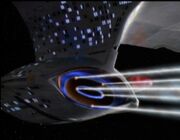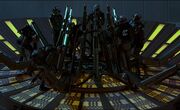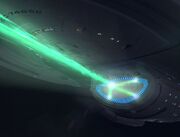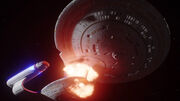AT: "xx"
The navigational deflector of the USS Enterprise-A

The navigational deflector of the alternate reality USS Enterprise opens

The navigational deflector of a Template:ShipClass starship
The navigational deflector (also called the deflector dish, the deflector array or the nav deflector) is a component of many starships, and is used to deflect space debris, asteroids, microscopic particles and other objects that might collide with the ship. At warp speed the deflector is virtually indispensable for most starships as even the most minute particle can cause serious damage to a ship when it is traveling at superluminal velocities. (VOY: "Alliances")
Technical Data
The deflector commonly takes the form of a dish-shaped force beam generator containing heavy-duty subspace accelerators at the extreme forward end of the vessel's secondary hull. It performs its primary function by emitting low-power deflector shields to deflect microscopic particles and higher-powered deflector beams and/or tractor beams to deflect larger objects. (Star Trek: First Contact; VOY: "Alliances", "Shattered")
One potential problem of using the deflector is that the deflector beams produced cause a great deal of subspace distortion, which can hinder the effectiveness of a starship's sensors, and as a result of this the long-range sensor arrays are placed in a circular fashion around the deflector. Not only does mounting the sensor arrays in this fashion reduce subspace interference by allowing both the sensors and the deflector beams to point on the same axis, essentially allowing the sensors to look through the distortion, it also allows for rapid reception of data which then could allow the computer to scan far ahead for navigational purposes.
In the event of combat, the navigation deflector performs as the very first stage of a starship's defenses - the deflector can deflect most laser fire and primitive projectile weapons. However, the deflector cannot deflect more complex weaponry such as directed energy weapons or more sophisticated projectile weapons, such as photon torpedoes.
A deflector's energy can be extended outward to protect other ships. In 2266, the USS Enterprise extended its deflector shield around Harry Mudd's class J vessel to temporarily protect it from asteroids while its crew were transported to safety. (TOS: "Mudd's Women")
Ordinarily, Federation starships were equipped with a single external deflector dish. Early versions of this device were sometimes known as a "Meteorite Beam" (TOS: "The Cage"). In recent years, some starships are known to have more than one deflector. One example of this is the Template:ShipClass, which has its main deflector located between the extreme forwards of decks 10 through 13 while the secondary deflector is located on the extreme forward of deck 6.
The deflector of the USS Enterprise-E was charged with antiprotons while the Borg were modifying it. This proved to be a potential hazard as particle weapons fire hitting the deflector could destroy much of the ship. (Star Trek: First Contact)
Components of the system
- Booster modulator
- Collimator
- Deflector field
- Emitter array
- Force beam generator
- Induction stabilizer
- Maglock
Other uses

Failed attempt at asteroid deflection

Due to its ability to project a wide variety of energies and particles, the navigational deflector is an extremely versatile piece of equipment. Many starship crews have made one-time modifications to the dish to solve whatever problem they may be facing.
Enterprise (NX-01)
In 2154, the navigational deflector of Enterprise NX-01 was used to generate a deflector pulse which destroyed Sphere 41 and thus disrupting the entire network of spheres in the Delphic Expanse. Modifications had to be made, however, to prevent the pulse from rupturing EPS conduits throughout the ship. (ENT: "Countdown", "Zero Hour")
Later that year, the NX-01's deflector was modified to emit a positron burst, which disabled Harrad-Sar's barge when it passed through the grappling line of his ship. (ENT: "Bound")
USS Enterprise (NCC-1701)
The USS Enterprise used its deflector to attempt to shift a large asteroid off course when it threatened the planet Amerind in 2268. The attempt failed and caused damage to the ship's power (TOS: "The Paradise Syndrome").
USS Enterprise (NCC-1701-B)
In 2293, Captains Montgomery Scott and James T. Kirk modified the deflector of the USS Enterprise-B to produce a resonance burst in order to simulate an antimatter explosion when the ship became caught in the Nexus energy ribbon. (Star Trek Generations)
USS Enterprise (NCC-1701-D)

The USS Enterprise-D fires its deflector dish as a weapon
- The crew of the USS Enterprise-D used the deflector to channel an extremely large amount of energy at a controlled rate - both as a weapon against a Borg cube in 2366 (TNG: "The Best of Both Worlds", "The Best of Both Worlds, Part II") and as an energy source hoping to escape a Tyken's Rift in 2367. (TNG: "Night Terrors") Although the energy beam had a greater power output than the ship's complement of weapons, using the deflector for this purpose was extremely impractical and only ever used on two occasions for three reasons:
- Channeling such a large amount of energy through the deflector made substantial drains on the ship's power systems, notably from the warp engines. This also meant that the beam could only be fired if the ship was traveling at sublight velocities.
- The deflector dish would burn out following the energy beam discharge, requiring extensive repairs, possibly replacement of the deflector altogether.
- The high levels of radiation produced by the energy beam require the evacuation of the entire forward half of the secondary hull and the lower three decks of the saucer section of a Template:ShipClass starship.
- Also in 2367, the Enterprise-D's deflector was modified to amplify and reflect the subspace frequencies produced by a cosmic string fragment to change the trajectory of a group of two-dimensional beings that threatened to destroy the ship. (TNG: "The Loss")

The deflector dish fires 5 beams of light
- In 2368, the deflector dish was modified to send 5 beams of light for exactly 8.3 seconds into the clouded atmosphere of Penthara IV, together with a modified phaser blast. This would ionize dust particles in the planet's atmosphere, which would be converted into high-energy plasma. This plasma was then absorbed by the deflector shields of the Enterprise-D and redirected into space. Warp power had to be rerouted to the deflector dish to create enough energy for the massive undertaking. (TNG: "A Matter of Time")
- In three different alternate timelines, the deflector was modified to emit an inverse tachyon pulse to scan beyond the subspace barrier, this being done to ascertain the workings of a anti-time eruption. The convergence of the three tachyon pulse at the same point in space in multiple timeframes caused a paradox which created the eruption in the first instance. (TNG: "All Good Things...")
USS Enterprise (NCC-1701-E)

The Enterprise-E deflector heavily modified by the Borg.
- A group of Borg attempted to modify the deflector of the USS Enterprise-E to perform as an interplexing beacon so as to contact the Collective of the 21st century. The crew of the Enterprise prevented the attempt by detaching and destroying the deflector. The movement controller unit of the Enterprise-E deflector was labeled "AE-35". (Star Trek: First Contact)
USS Defiant (NX-74205)
The USS Defiant with deflector in the foreground
- Navigational deflectors can also be used to emit graviton pulses. (DS9: "Once More Unto the Breach")
- In an alternate timeline in early 2372, the USS Defiant's deflector was used to shunt an excess amount of warp energy from the ship's warp core that threatened to destroy the ship in a warp core breach. (DS9: "The Visitor")
- During 2372 the deflector of the Defiant was modified in just ten minutes to perform as a single-shot phaser emitter when the ship was under attack from a Jem'Hadar fighter in the atmosphere of a class J gas giant. Only one shot could be fired with this makeshift phaser emitter as it overloaded with the first shot. (DS9: "Starship Down")
- In 2374, the Defiant used its nav deflector to fool the numerous externally powered orbital weapon platforms defending one of the planets in the Chin'toka system into destroying their own remote power source by projecting a false Federation warp signature onto the power station. (DS9: "Tears of the Prophets")
USS Voyager (NCC-74656)

The USS Voyager emits a resonant graviton beam
- In 2371, the crew of the USS Voyager modifed the ship's main deflector to emit a dampening field and warp particles diverted from the nacelles, along with a Dekyon beam. The navigational array was also part of an analysis for possible issues in regards to being stuck in a type-4 quantum singularity. (VOY: "Parallax")
- The transporter signal was boosted on board Voyager by re-routing the transporters directly through the deflector. (VOY: "Non Sequitur")
- The ship's main deflector was modified by the Borg drone Seven of Nine to open a portal into fluidic space. (VOY: "Scorpion, Part II")
- In 2374, a badly damaged Voyager lost its navigational deflector shields along with many other systems during the Year of Hell. Encountering a micro-meteoroid shower, they were unprotected without their deflector and the ship began suffering even more damage. Captain Janeway restored the shields, although she was burned due to a massive fire in the Deflector room. (VOY: "Year of Hell, Part II")
- In 2375, Chakotay found a way out of chaotic space by routing Voyager's sensor array through the ship's deflector dish, thereby increasing the deflector's amplitude. (VOY: "The Fight")
- Before her time on Voyager, B'Elanna Torres used a deflector array combined with a holoemitter to project a starship into space. (VOY: "Prototype")
- The Borg "children" used a tractor beam in an attempt to steal Voyager's main deflector, to use it as an interplexing beacon for contacting the Borg. (VOY: "Collective")
- Chakotay used the deflector as a "lighting rod" to stop Voyager from being fractured into different time periods by a temporal anomaly. (VOY: "Shattered")
Other starships

The Odyssey's deflector destroyed
- A kamikaze attack on the navigational deflector of the USS Odyssey in 2370 caused a chain reaction causing the ship's destruction. (DS9: "The Jem'Hadar")
External link
- Template:NCwiki
